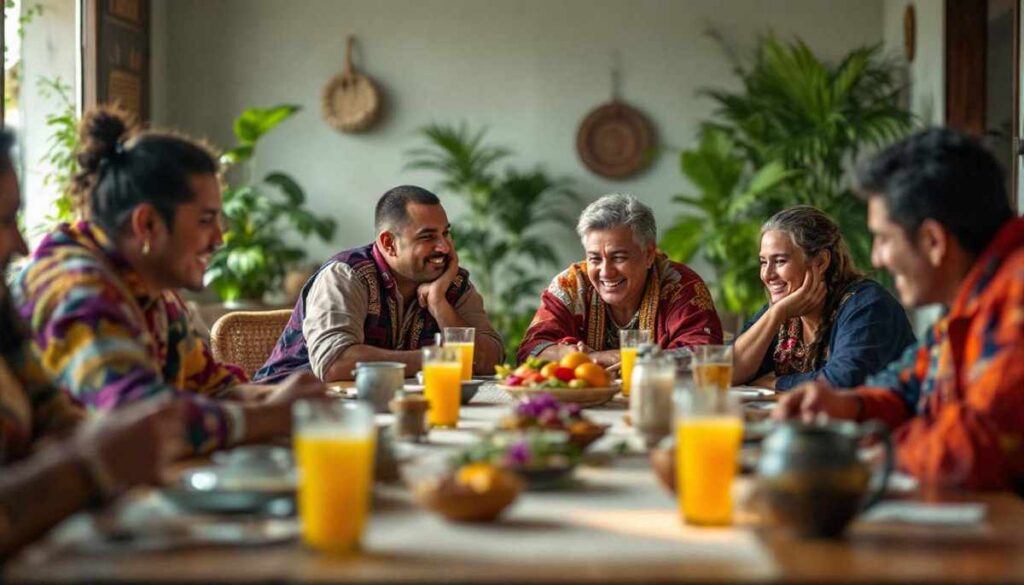
Traditional Peruvian social gathering showing the hierarchy in seating
In Peru, seating arrangements often communicate more than mere comfort; they reflect cultural values, social structures, and personal relationships. Understanding these hierarchies is essential for appreciating the nuances present in gatherings ranging from family celebrations to professional meetings. This article delves into the profound implications of seating positions in Peruvian society.
The Cultural Importance of Seating Arrangements in Peru
Seating arrangements in Peru are steeped in tradition and cultural significance. They often denote respect, authority, and social standing. In gatherings such as weddings, communal meals, and religious ceremonies, where individuals sit can speak volumes about their status within the community. This cultural importance is rooted deeply in the history and evolution of Peruvian society.
Historical Overview of Seating peru hierarchy sitting position
The historical significance of seating arrangements can be traced back to the indigenous cultures of Peru, which had strict societal structures. The Inca Empire, for instance, had clear hierarchies, with the Sapa Inca at the highest position. Seating was not merely functional but was a ritualistic aspect of political and social ceremonies.
As Spanish colonial influences merged with indigenous practices, new layers of hierarchy were added, transforming traditional seating into a complex interplay of power dynamics. Even in contemporary Peruvian society, the remnants of these historical practices continue to shape how people sit and interact. For example, during festivals, the seating arrangements may reflect not only familial ties but also the roles individuals play within the community, such as leaders of local organizations or respected elders. The careful orchestration of who sits where can create a sense of unity while simultaneously reinforcing the established social order.
The Social Implications of peru hierarchy sitting position
In modern social contexts, seating positions can imply relationships and social connections among different individuals. For instance, in family gatherings, the seating arrangement may reflect age, wisdom, or authority. Elders might be seated at the head of the table, signifying respect and honor, while younger members sit toward the periphery.
In public or professional settings, individuals who hold managerial or supervisory roles often occupy positions that afford them visibility and prominence. This dynamic contributes to both the management of power and the reinforcement of social order within groups. Moreover, the act of choosing where to sit can be a strategic decision, as it allows individuals to align themselves with those they wish to be associated with or to distance themselves from others. This behavior is particularly evident in business meetings, where seating choices can signal alliances, rivalries, or even intentions to negotiate. The nuances of these arrangements reveal much about interpersonal dynamics and the underlying cultural values that continue to thrive in Peruvian society.
The Symbolism Behind Different Sitting Positions
Beyond the mere act of sitting, the positions people adopt carry symbolism that resonates culturally. In Peru, for instance, sitting down can mirror levels of authority, intimacy, or formality in relationships. The way individuals choose to position themselves provides insight into their status and relationships with others present.
The Power Dynamics of Seating
Power dynamics are particularly evident when considering the localized contexts in which individuals gather. In a business meeting, for example, the person leading the discussion generally occupies a seat at the center or head of the table. This not only signifies leadership but also reinforces the hierarchy established within a corporate framework.
Conversely, an informal gathering among friends might reflect a more egalitarian approach, where all individuals can choose their seating based on comfort rather than status. These distinctions highlight how seating dynamics can shift based on the setting and the relationships involved. In many cultures, the act of sitting can also be a subtle form of communication; for instance, leaning in while seated can indicate engagement and interest, while leaning back might suggest disinterest or a desire for personal space. Such nuances can significantly impact interpersonal interactions and the overall atmosphere of the gathering.
The Role of Gender in Seating Arrangements
Gender plays a significant role in determining seating arrangements within Peruvian culture. Traditionally, men have occupied positions of authority, often seated at the head of gatherings. However, there is a growing shift towards more egalitarian seating conventions, reflecting broader societal changes regarding gender roles.
In family settings, these shifts can lead to evolving dynamics, where women are recognized for their contributions and may occupy prominent positions. This adaptation signifies the changing perceptions of gender roles within both familial and social contexts. Moreover, the seating choices made during communal meals can also reflect deeper cultural values; for instance, women may be encouraged to sit together, fostering a sense of solidarity and shared experience. This practice not only reinforces bonds among women but also challenges traditional norms by allowing them to voice their opinions freely in a supportive environment, thereby contributing to the ongoing dialogue about gender equality in society.
The Impact of Seating Hierarchy on Interpersonal Relationships
Seating hierarchy impacts interpersonal relationships significantly. The positions individuals assume during gatherings can either strengthen or strain relationships, depending on how these hierarchies are perceived and respected.
Seating Positions in Family Gatherings
Family gatherings often serve as a microcosm of larger societal trends regarding power and authority. The seating arrangement can speak to the level of respect afforded to various family members. Elder relatives generally occupy seats of honor, dictating the flow of conversation and decision-making during family discussions.
This positioning not only illustrates respect but reinforces familial roles and responsibilities, allowing for a clear delineation of roles among family members. For instance, younger generations may find themselves seated at the periphery, which can foster a sense of deference while simultaneously highlighting the wisdom and experience of older relatives. This dynamic can create a nurturing environment where stories and traditions are passed down, but it can also lead to feelings of exclusion among those who are relegated to less prominent positions.
Seating Arrangements in Professional Settings
In professional settings, seating arrangements can be critical for effective communication and collaboration. The choice of seats in a boardroom can suggest who is leading the meeting and who participates as support staff. For example, decision-makers often sit around the table, while assistants or junior staff may be positioned further away.
Such arrangements can impact dynamics in discussions and overall organizational culture, influencing how feedback is given and received, and shaping team collaboration. Moreover, the physical layout of a workspace can foster or hinder innovation; open seating plans may encourage spontaneous brainstorming sessions, while rigid hierarchies can stifle creativity. The psychological implications of seating positions extend beyond mere comfort; they can affect confidence levels and willingness to contribute ideas, ultimately shaping the trajectory of projects and team cohesion.
The Modern Interpretation of Seating Hierarchy in Peru
As Peruvian society evolves, so do the interpretations of seating hierarchy. With globalization and technological advancements, many traditional norms are being redefined. This evolution raises questions about the future of these cultural practices.
Changes in Seating Traditions Over Time
There has been a noticeable shift in seating traditions with the influx of diverse influences. Younger generations are less inclined to conform strictly to traditional hierarchies, often opting for informal seating arrangements that promote inclusivity rather than exclusivity. For example, a gathering that allows everyone to sit wherever they feel comfortable reflects a shift toward valuing personal choice over hierarchical structures.
Such changes indicate a broader shift in societal values that prioritize equality and collaborative dynamics, diverging from the more rigidly defined hierarchies of the past. This transformation is particularly evident in urban settings, where the blending of cultures has led to a more eclectic approach to social gatherings. In these environments, seating arrangements often reflect a mix of traditional Peruvian customs and contemporary global practices, creating spaces that encourage dialogue and connection among diverse groups.
The Future of Seating Hierarchy in Peru
Looking ahead, the future of seating hierarchy in Peru seems poised for continued evolution. As cultural exchanges become more prevalent, individuals may adopt a blend of traditional and modern seating practices that reflect their values and relationships. The rise of digital communication has also influenced how people perceive social interactions; virtual meetings often prioritize equal participation, which may carry over into physical spaces.
Moreover, the increasing emphasis on sustainability and community engagement is likely to shape future seating arrangements. For instance, gatherings that utilize communal tables or outdoor settings can foster a sense of belonging and shared responsibility, breaking down barriers that traditional seating hierarchies once upheld. Ultimately, understanding Peru’s seating hierarchy not only illuminates cultural norms but also highlights the fascinating interplay of tradition and modernity in defining social spaces. As these norms continue to evolve, they will undoubtedly influence how future generations perceive and utilize seating arrangements in their social interactions.




